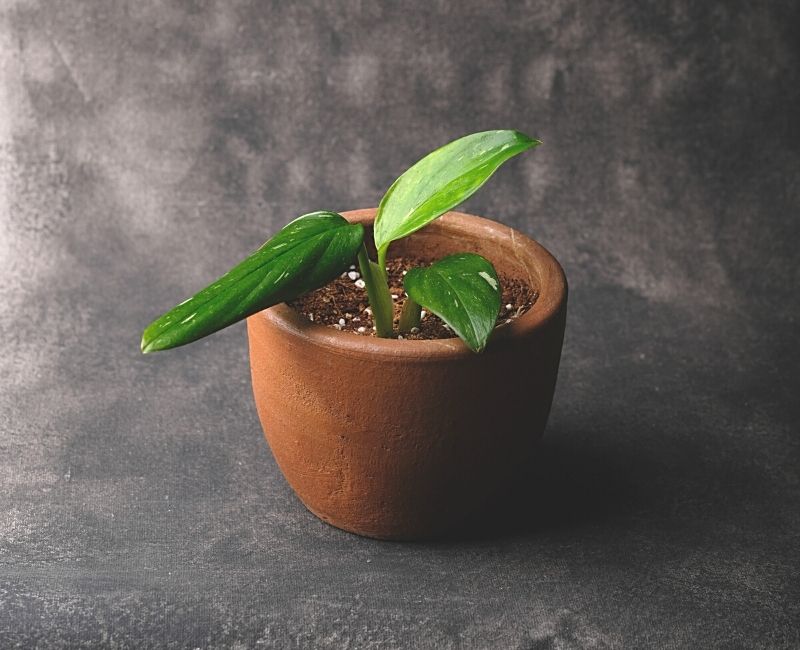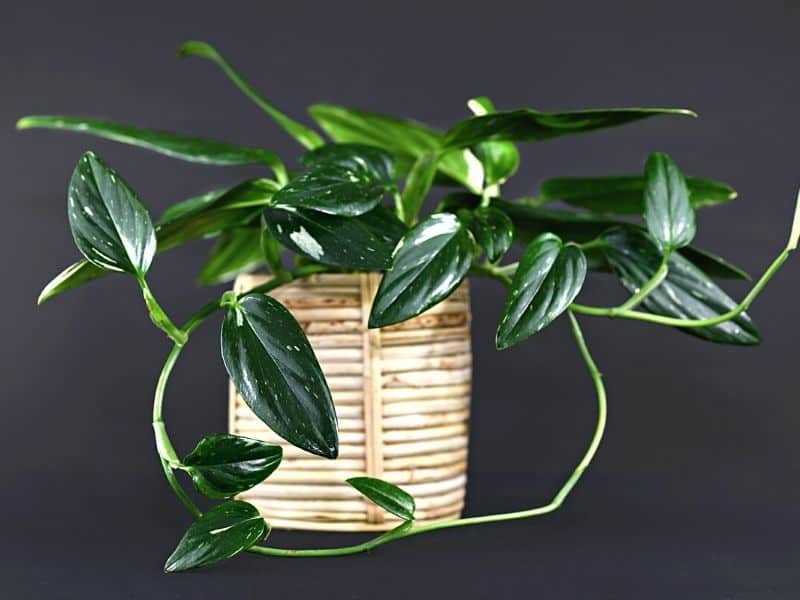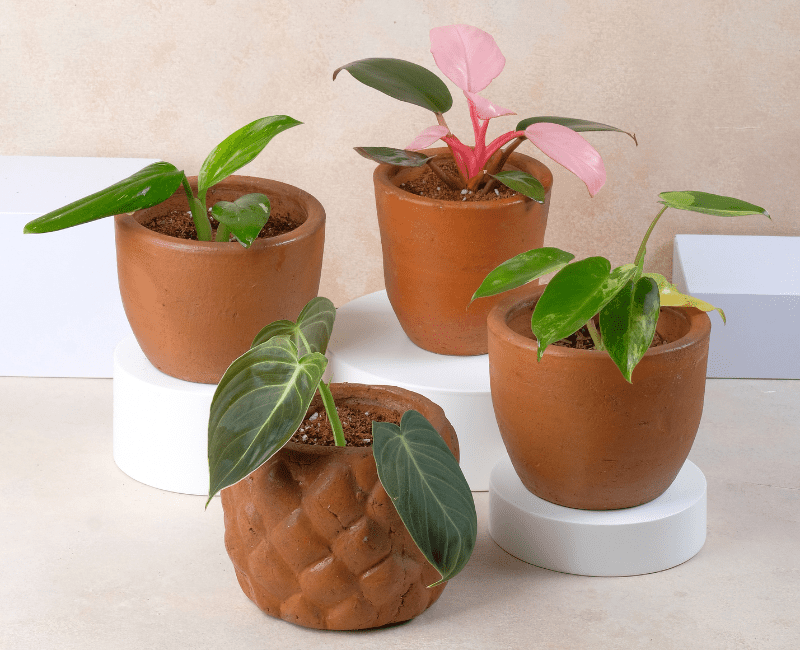Monstera standleyana ‘Albo Variegata’ is a stunning climber with small oval leaves about 6 inches long. The dark green leaves may have spots, splashes, and broad bands of pure white. Please note that not all of these plants will have a large splash of white.
Philodendron Rugosum Care Guide Overview
- How To Plant (when & where)
- How To Grow (staking, watering, fertilizing, humidity, mulching)
- How To Trim And Prune
- How To Pot And Repot
- How To Propagate (when & how)
- And Pests and Diseases, Plant Species, Companions, Toxicity
Characteristics
- Scientific name and common names: Albo Variegata, Five Holes Plant Philodendron Standleyana and Philodendron Cobra.
- Origin: Honduras, Nicaragua, and Panama
- Indoor or Outdoor plant: Both
- Height and Structure Indoors: 3 to 5 feet
- Outdoors: up to 20 feet
- Temperature: 18 to 27 °C
- Flower Color: White
How To Plant a Monstera Standleyana

It grows well in loose soil rich in humus. Mix two parts of potting soil, one part of coarse sand and one part of fine orchid bark. The soil should be evenly moist.
Planting Time
It is best if you plant it during springtime, in March, to be specific.
Spacing
Monstera standleyana likes spacious containers so that it can spread its roots. The rule for this plant: the wider the roots, the wider and longer your plant will be! The container should have a diameter of between 25cm and 50cm and a depth of about 25cm.
Light
Monstera Standleyana does not like direct or strong sunlight. It prefers lower light conditions than other houseplants, so shaded or partially shaded places will be great for this. Low indirect sunlight is the best solution for the plant.
To clarify, the room should be bright but without the direct impact of sunlight (low light conditions will cause stunted growth). A bright room with lots of shade would be ideal. Also, remember that variegated plants need a little more light than completely green plants, as the white parts cannot photosynthesize.
Soil
Your Monstera Standleyana likes loose, well-drained soils. The soil, which is light and airy, allows the water to drain easily. The ideal PH is between 5 to 7.5.
How To Grow a Monstera Standleyana

Growth habits
In terms of size, you can expect it to be influenced a lot by its environment. The minimum size it can reach is around 1 meter high and 1 meter wide. But the plant is a prolific climbing plant and if given the opportunity and the suitable climate, it can reach a maximum of 19 feet in height and 6 feet in width.
Staking
Monsteras are climbers and love to climb surfaces that are vertical. If you want to grow this type of plant in height rather than in width, use moss sticks to guide its growth upwards.
Watering
Watering a Monstera Standleyana is like most other plants. It needs water regularly. But you don’t want to overwater it, either. When you water the plant, check the soil first. Stick your finger in the soil up to your knuckles. If the soil is still wet, do not water it yet. If the soil is dry, go ahead and water it. Do not let the soil dry out before watering. It’s a big no-no. When you water your plant, use enough water so that all the soil is moist but not soggy.
Fertilizing
Fertilize it carefully and at least 15 cm from the base of the plant. You shouldn’t over-fertilize it as the heavy salts left in the soil will cause your plant to dry out and die. Also, never do this in winter when most plants don’t need food on those days.
Humidity
The Monstera Standleyana thrives on humidity. Imitate their original homes. There are two main ways to get moisture for your plant. First of all, there is the pebble tray method. Fill a tray full of stones. Then fill the tank with water but make sure that the water does not exceed the rocks.
Place your flowerpot on the pebbles. When water evaporates, it creates moisture. If you are using a hanging pot, the first method may not be the best for you. Your second option is to spray the plant with a spray bottle. We recommend that you spray the leaves with water several times a week.
Mulching
You can add mulch to your water, keeping your plant fresh and healthy (plus, it will keep your plant standing upright). It is best to make your mulch. It won’t take a long time and will do your plants and your wallet good too. Collect leaves, branches, and other organic material at a local park if you don’t have a garden. Shred them and you have your high quality mulch! You can also shred paper and use them as mulch.
Trimming and Pruning
Monstera standleyana are vigorous growers. However, they will usually not grow as large as some of the other varieties of Monstera. You should prune your plant to ensure you maintain its size and shape. The pruning of the foliage also helps prevent some of them from straying. In addition to making the plant look great, pruning also keeps it healthy. By removing dead leaves, you remove retarded parts of the plant that do not grow but still use up its resources. This preserves these resources for new growth.
Pot And Repotting
As with any potted houseplant, not to mention a tropical plant, drainage holes are a must. Repotting should be done in spring or summer at the latest when the plant is actively growing. Usually, repotting is not necessary until every 18-24 months or if the plant is visibly protruding from its pot or roots are extending out of the pot, whichever comes first. When repotting, you should get rid of dead or diseased roots as well as roots that are too long or soft. Use a pot that is only 2-4 inches taller than the current pot; you don’t want to drown out the roots by using a large pot.
Monstera Standleyana Propagation

Pruning of the stems is necessary to grow a Monstera Standleyana. Do this type of plant propagation only in the spring. Monstera Standleyana can also be grown in water. Put the stem in the water to make your plant even nicer!
Divide And Transplant
The plant grows quite quickly. As such, its roots do too. This means that you will need to report the plant every 12 months. The best time to transplant is during spring as the plant begins to actively grow. This allows it to handle the shock of being in movement. And, after that, the new space will allow it to take advantage of the warm climate to grow faster. With monstera standleyana, you will likely see the roots sprouting on their own once you are 11 or 12 months after your last repotting.
Pests And Diseases
Monstera Standleyana is not too affected by diseases or pests. However, some pests seem to attack the plant more often. Spider mites and aphids are some of them. Aphids harm your plant by sucking out the sap. Removing nutrients from your plant in the process. The easiest way to identify that aphids are present is to observe the presence of sap on different parts of your plant. The sap-covered areas mean aphids were working there.
There is also root rot. This is highly preventable if you avoid overwatering the plant and use well-drained soil. You want to take extra care here because root rot lacks any known cure and is difficult to recover from.
Another common problem is spider mites. These leave behind a small spiderweb-like material for you to spot. Likewise, they make the leaves of your plant develop brown spots. When you see them, cut out the affected sections. Then use an insecticidal soap.
Plant Species
Monstera Adansonia
It is also known as the Swiss Cheese Factory. This specie is smaller than the deliciosa. It has heart-shaped dark green leaves with cutouts. Some are round in shape, while some are narrower.
Monstera obliqua
Monstera obliqua is often described as having more holes than leaves. They form similarly shaped holes inside the leaves, and the leaves themselves are narrow rather than oval or arrow-shaped.
Monstera dubia
Sometimes referred to as a pebble plant, Monstera dubia comes out with beautiful heart-shaped and variegated leaves. They are usually green and yellow leaves. The plant does not bloom until it has reached maturity. Before you know it, the mature leaves will start hanging from the vine. As the plant grows, these leaves lie flat against the pole you are using.
Monstera karstenianum
The plant has skin-like green leaves that feel like Braille on the fingertips. The texture and design stand out from the leaf. And the stems are long and twist like vines. This plant grows quite bushy and attractive in a regular container. (more on Monstera Karstenianum)
Companions
The Monstera companion plants are sensitive and thus, proper selection and care must be observed. Pothos is a companion plant that can grow well in low sunlight or indirect light, and it can be grown with Monstera Standleyana in the same pot.
Philodendron IS ANOTHER companion plant that can be grown with Monstera Standleyana. This is because they share the same conditions for their growth, and both are low-maintenance plants.
Toxicity
This type of plant is mildly poisonous to humans and poisonous to dogs and cats. Symptoms of exposure include mouth irritation, pain and swelling of the mouth, lips and tongue, excessive salivation, difficulty swallowing and vomiting.


